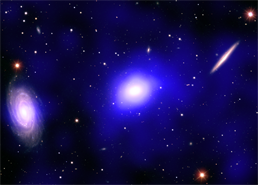Overview

LGG 402. Mouseover to remove X-ray |
The CLoGS project aims to be be the first statistically complete survey of galaxy groups observed in the X-ray, optical and radio wavebands. Since >50% of galaxies in the local volume reside in groups, they are a key environment for studies of galaxy evolution. As the locus of much of the mass in the nearby Universe, and the environment in which the hot, X-ray emitting intergalactic medium first becomes important, groups are also fundamental to our understanding of AGN feedback and structure formation. Our main science goals include:
- Determining the basic physical properties of a representative sample of groups for the first time.
- Examining the temperature and density structure of the gaseous halos of groups, the ability of groups to retain gas, and the fraction of systems with central cooling cores.
- Characterisation of the AGN population in groups, and examination of their impact on the intra-group gas and member galaxies.
- Study of the galaxy population of groups, and the relationships between galaxies, their groups, star formation and nuclear activity.
- Identification of new groups and new classes of groups, such as the high entropy systems predicted by simulations (e.g., McCarthy et al. 2010).
The CLoGS sample consists of 53 candidate groups in the local Universe (<80 Mpc), so high-quality optical data are already available (from, e.g., LEDA). Combining archival data with new observations by the XMM-Newton (800 ks) and of Chandra (210 ks) X-ray observatories, we expect to complete X-ray coverage of the full sample by early 2019. As low-frequency radio data provide the best chance of detecting older, fading radio galaxies, we have also observed the full sample with the Giant Metrewave Radio Telescope at 610 and 235 MHz (208 hours). The sample was selected to be within the coverage of the NVSS 1.4 GHz and TGSS 150 MHz surveys. We have also surveyed the dominant galaxies of the groups for molecular gas via CO observations, and have Hα imaging of about 70% of the groups. These observations provide a window on the AGN feedback cycle in the central galaxies, and on the impact of the group environment on star formation.
Sample selection and X-ray observations of the 26-group high-richness subsample, are described in CLoGS paper I, while Paper II and paper III describe the radio properties of the dominant galaxies of the high-richness and low-richness groups respectively. Results from our CO survey can be found in O'Sullivan et al. (2018b) and O'Sullivan et al. (2015).